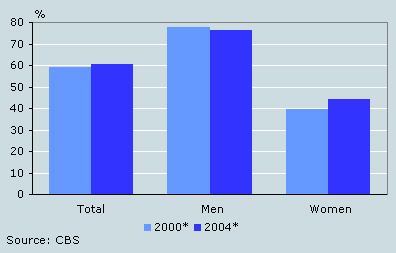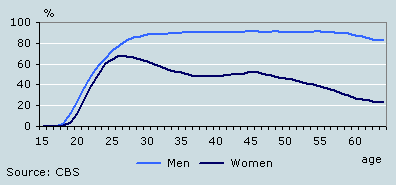Increasing number of women financially independent

The proportion of financially independent women increased between 2000 and 2004, whereas the number of financially independent men dropped.
More men than women financially independent
In 2004, nearly 11 million people in the Netherlands were in the 15-65 age bracket. Over 60 percent of them were financially independent: their net annual income was 10,300 euro or more. The rate of financially independent women was 44 percent in 2004, the rate for men was 76 percent.
Number of financially independent men and women

Gender gap narrowing
The rate of financially independent women increased from 40 to 44 percent between 2000 and 2004. The rate in the male population decreased from 78 to 76 percent over the same period. As more and more women are employed, the relative number of financially independent women is growing. The decline among men was partly due to an increase in the number of men who received unemployment benefits in the period 2000-2004.
Traditional role patterns
Discrepancies among men and women regarding financial independence start at an early age. At the age of 30, nine out of ten men are financially independent, as against six out of ten women. At the age of 60, nine out of ten men are still financially independent. Among women, financial independence gradually declines, when they are aged between 25 and 40. Between 40 and 45, there is a slight increase.
Traditional role patterns partly account for this development.
Women, for instance, reduce their working hours before they have reached the age of 30 or stop working altogether, because there are young children to look after, whereas the majority of men continue to work.
Number of financially independent men and women by age, 2000/2004

Fewer older people financially independent
From the age of 50 onwards, an increasing number of people depend on benefits. Most men, however, receive benefits related to the wage they used to earn and therefore the number of financially independent older men remains high.
Due to their employment record, women usually receive lower benefits. Moreover, the number of women over 50 without any source of income is increasing. Only one quarter of women in the 60-64 age category are currently financially independent.
Wim Bos